Last updated on November 26th, 2023
Featured image: Digby, Nova Scotia – Discover Nova Scotia through Maud Lewis’ eyes | Photo by daveyandsky via Tourism Nova Scotia
Places to experience Maud’s life and art
By Sandra Phinney, Contributor, Atlantic Canada
In the early 1950s, my mother drove my sister, me, and some friends on Sunday afternoons 100 kilometres from our home in Yarmouth to Digby, Nova Scotia, to skate on an indoor rink. On the way back, we often stopped on the side of the road in Marshalltown at what I called “The Gingerbread House.” It was the home of a female folk artist.
The woman was short, and her wispy white hair was loosely tied back in a bun. Hunched and gnarled like the witch in Hansel and Gretel, my friends thought she was creepy but she didn’t scare me. Never having known a grandmother, I secretly called her “Granny.” Granny always had a shy smile for us. She was tiny and reminded me of a bird. When she painted, because her hands were arthritic and misshapen, she held onto a brush like a chickadee clutching a branch.
Granny’s small house was close to the road. It was only 12 feet by 14 feet with a small loft. Outside, there were flowers, birds, and butterflies painted on its single window, the front door, and shutters. The inside was pure whimsy. Every surface popped with more painted flowers, birds, butterflies and animals, all rendered in bright primary colours. The only thing I didn’t like was the rancid smell—a cross between mushed green bananas and turpentine—probably from the paints she used and rags that were never cleaned. Sometimes, my eyes itched.

Jim Corning, retired engineer and friend of the author, visits Maud in the 1960s / Photo by David Corning
There was always a stack of Granny’s paintings on a chair next to the door or in a pile under the window. Some had prancing horses that pulled sleighs through winter scenes, while others had red-yoked oxen with giant eyelashes and big brown eyes that always looked befuddled.
Mama would pick up a painting from the top of the pile, then give the woman the asking price of two dollars. Sitting at a small table across from the wood stove, a long-legged old man with a frown and a face full of whiskers kept watch with his beady eyes. Nodding, he took the money and put it in a blue Players Tobacco tin in the middle of the table. He never spoke. When the old woman turned back to see us out, Mama would slip another two dollars into the pouch of her apron, and whisper, “This is for you.” Granny tilted her head, smiled, and looked at the floor.
I later learned that Mama bought the old woman’s paintings as an act of charity. She knew the couple was in dire straits, but she considered the woman’s work child-like. The paintings were used to start fires in our big living room fireplace; none survived.

Maud Lewis’ painting “Black Cats and Tulips”
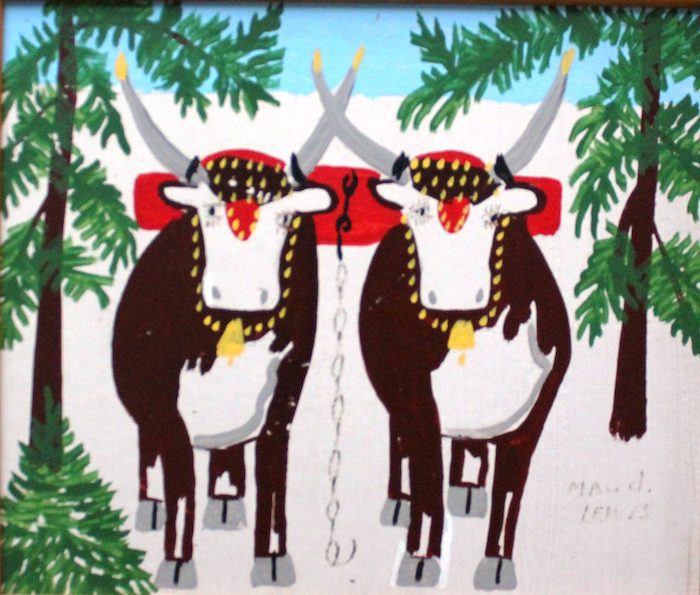
Maud Lewis’ painting “Two Oxen in Winter”
Discovering Maud Lewis
I was an adult when I finally framed the story. The woman’s name was Maud Lewis. Maud and her husband, Everett, were poor; they didn’t have electricity or running water. He was miserly and, at times, an abusive drunken brute. When sober, he was considerate and encouraged her to paint—some would say for the money that her work fetched.
Despite having disabilities from childhood—deformities possibly caused by polio, compounded by rheumatoid arthritis in later years—Maud painted on every imaginable surface: dustpans, windowpanes, scallop shells, even the stove in her home. “Just gettin’ my work on,” she’d say.
After her death in 1970, Maud Lewis became Canada’s most famous folk artist. Her paintings now grace the homes of admirers, patrons, and investors the world over and sell for $5,000-$40,000 at auctions and galleries. In the two years or so of our visits with Maud, my mother probably burned over $100,000 of collectible art.
For decades anthropologists have classified a certain group of people as “the Folk.” The Folk exist in different cultures around the world and have characteristics in common. Typically, they personify simplicity and sincerity. They often are rural, illiterate, humble, hardworking, and poor.
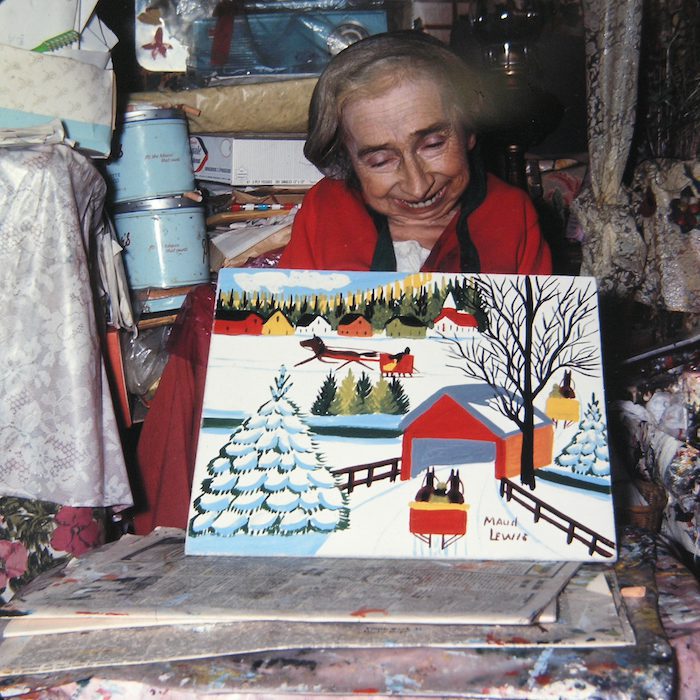
Original photo of Maud holding one of her paintings / Photo by David Corning
Maud never took an art lesson and never visited an art gallery, yet her work is pleasing to the senses, full of joy and unbridled happiness. I’ve often wondered where she found the courage, determination, and optimism to get on with living. Looking at Maud’s paintings gives me the feeling that she simply turned the world upside down then said, There there now. See? Everything’s OK. The world really is a good place.
Maud Lewis sites of interest to travellers
In 1984, after Maud and Everett had been dead for 14 and five years respectively, the Province of Nova Scotia purchased their neglected home for the Art Gallery of Nova Scotia (AGNS) in Halifax. Fourteen years later, The Scotiabank Maud Lewis Gallery opened, featuring the fully restored Maud Lewis Painted House inside the gallery’s own walls. It is truly a marvel, considering it is enclosed in the gallery in its entirety, just as it was when I visited her as a child. The AGNS also has a substantial body of Maud’s work. And, occasionally, there are exhibits of her work at the AGNS’ satellite gallery in her hometown of Yarmouth, Nova Scotia.

Replica of Maud Lewis’ painted house in the AGNS / Photo by Steve Farmer

Gravesite of Maud and Everett Lewis, North Range
In the village of Seabrook, on the outskirts of Digby, you’ll find a replica of Maud and Everett’s home, built by a retired fisherman, Murray Ross. Murray has done a remarkable job. Although his website reads like a dog’s breakfast and is top heavy with things the family sell related to Maud, you’ll find the actual site uncluttered and lovely.
About 10 kilometres away is a stunning steel frame where Maud and Everett lived in Marshalltown, designed by world-renowned architect Brian MacKay-Lyons. At night, it is lit up and you can see through the steel frames. I always like to imagine what life was like inside those walls. Adjacent to the house is a lovely garden and picnic area, with informative interpretive panels.
A short drive onto the North Range Road close by will take you to a small cemetery with Maud and Everett’s tombstone.
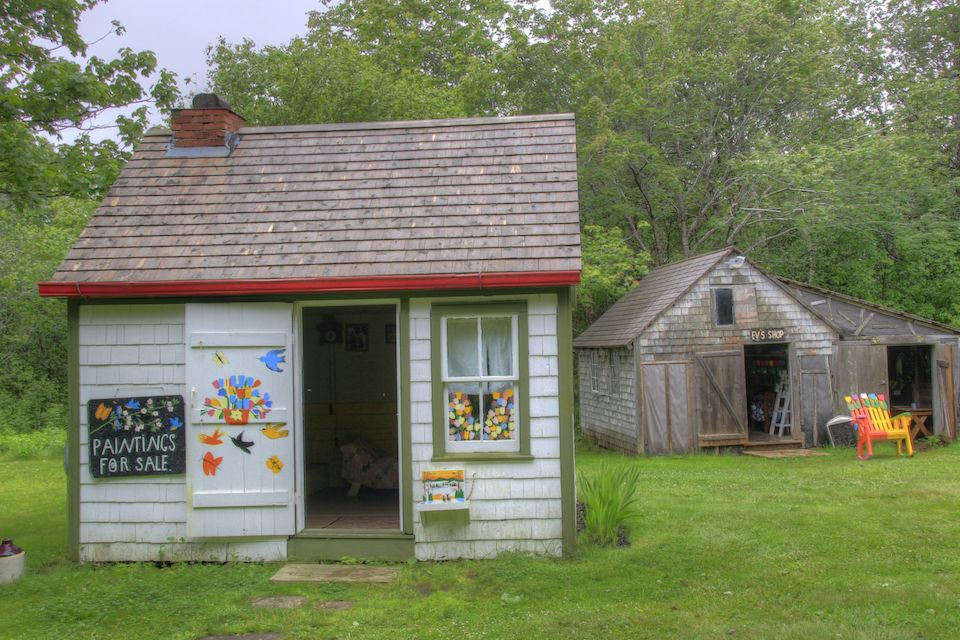
Replica of Maud Lewis’ house in Seabrook, NS

Steel frame Maud Lewis house in Marshalltown, NS
Maudie—the movie
Of course, even if you can’t visit these sites in person, you can get a great overview (and understanding) about her life and times through watching Maudie starring Sarah Hawkins and Ethan Hawke. Although the scriptwriter/director took some liberties with a few historical facts (after all, it’s a movie!) they kept the essence of her story intact and did a remarkable job.
A bonus for me was to visit the site where most of the movie was filmed in Keels, Newfoundland. Mind you, filming Maudie in NL is a bone of contention with Nova Scotians as the government of the day had dropped its subsidies to film companies back in 2015; otherwise, we like to think it would have been filmed in my home province. But I got over grumping about this when my travels to NL brought me close to Keels this summer. Once I learned Maudie had been filmed there, I visited this darling village not once but twice.
Selvy Mesh, the second-generation owner of the general store in Keels where a few scenes were shot, reminisced about the making of the movie. I loved spending time with him, and having chats with customers who came in for everything from cheese and bologna, to mailing a letter. Selvy’s turned the rear of the building into a small café with lots of big windows.
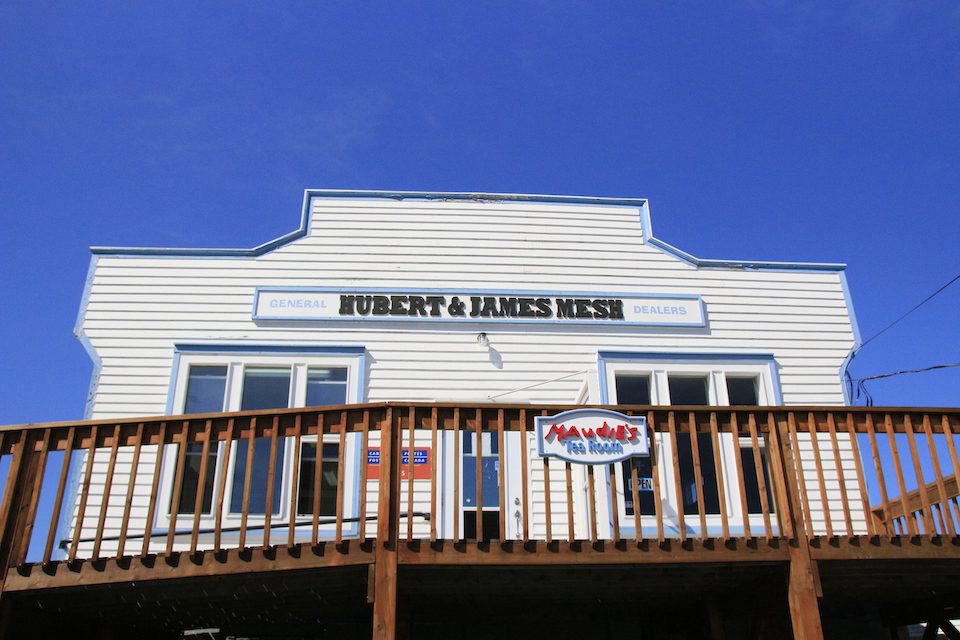
The general store that was part of the Maudie film set in Keels, NL
I planned my second visit to arrive around lunch and had visions of having a big bowl of pea soup or chili, but Selvy had closed the café for the season. Instead, I bought a jar of pickled mussels and later ate them in the car close to a large rock face featuring hundreds of holes the size of my fist, referred to locally as “the devil’s footprints.” And that, dear reader is a story for another time.
More About Atlantic Canada
30 Less-Travelled Places for Women in 2024
For our 30th anniversary, JourneyWoman reveals 30 less-travelled places for women in 2024, according to our writers and travel experts.
An Ode to Volunteers: Inspiring Lessons from the ‘July Project’ in Yarmouth, Nova Scotia
Acknowledging the volunteers and ‘heavenly invisibles’ who make our travels possible and are the backbones of our communities.
Going Psycho: Lessons from My Travels at Home
Inspired by the idea of ‘psychogeography, when we take time to slow down and experience things, we can discover extraordinary things close to home.

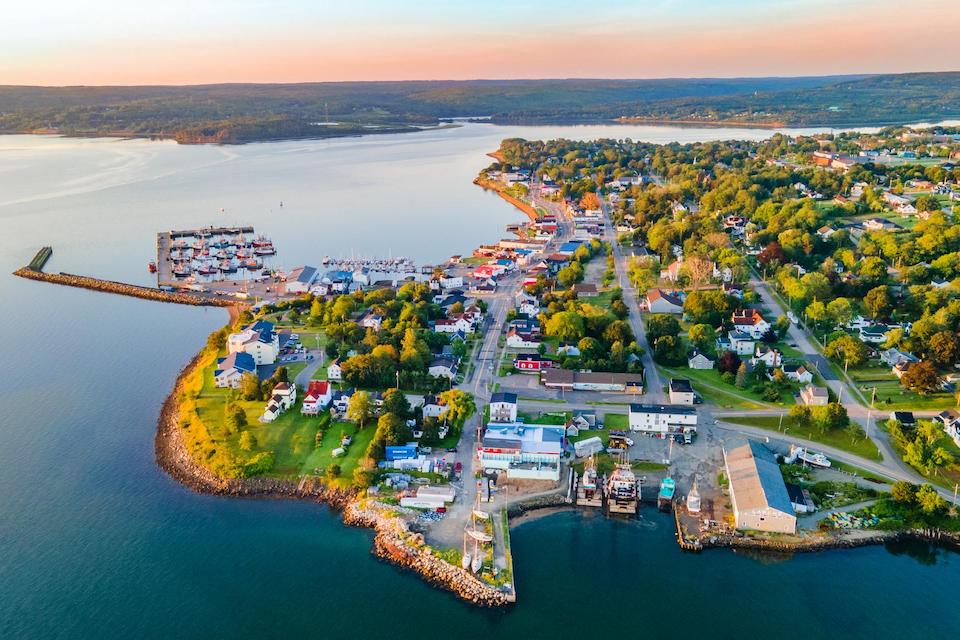



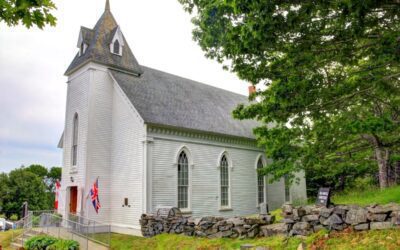

Thanks for sharing this! A very nice read. The house looks like something out of a picture book.
Happy you enjoyed this story! And, yes, her home really is like it came out of a picture book. I’ve always been grateful that the AGNS was able to preserve it. There is an entire book about how this was done. It took years (and a LOT of money!)
Thanks for popping into view with your comment! And, yes, her house is very much like a picture book. Whimsical and heart-warming.
Liked this article. I worked in a gallery in AB and when we received reproductions of Maude Lewis art I enjoyed them very much
My husband and I came upon the movie about Maude by accident and I am so glad we decided to watch it. What a great story that brought us both laughter and tears. She was a remarkable lady and I am so glad that people today can still enjoy and appreciate her talent and uplifting attitude through the art she left behind. Thank you to those who kept her memory and home alive for future generations.
I’m so happy you saw the movie and was introduced to “our Maud.” Appreciate you popping into view Connie!